SMART FORTWO COUPE 2011 Owner's Guide
Manufacturer: SMART, Model Year: 2011, Model line: FORTWO COUPE, Model: SMART FORTWO COUPE 2011Pages: 228, PDF Size: 11.48 MB
Page 31 of 228
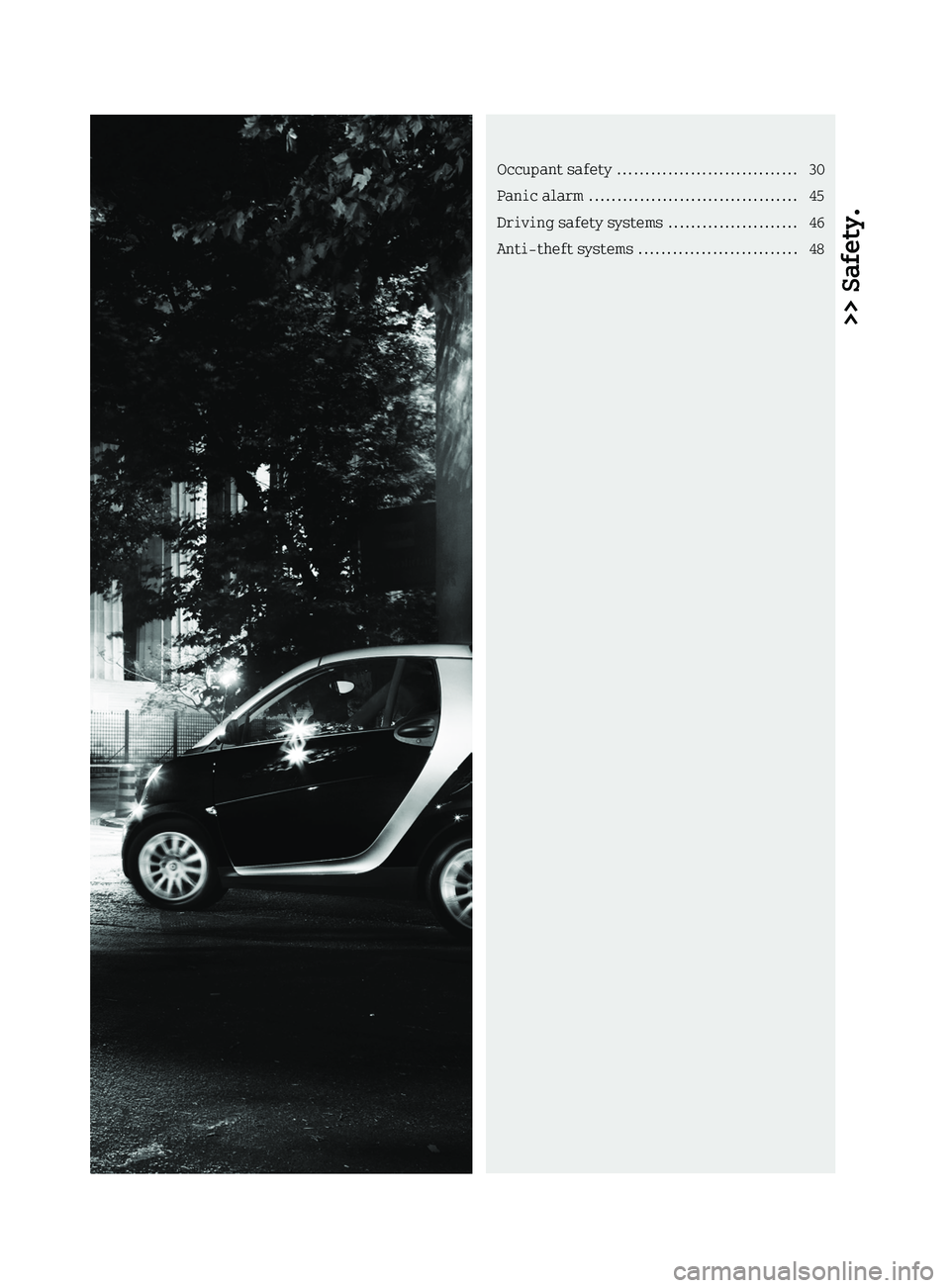
>> Safety.Occupant safety ................................30
Panic alarm .....................................45
Driving safety systems .......................46
Anti-theft systems ............................48
BA 451 USA, CA Edition A 2011; 1; 4, en-UShereepeVersion: 3.0.3.62010-05-11T15:12:26+02:00 - Seite 29
Page 32 of 228
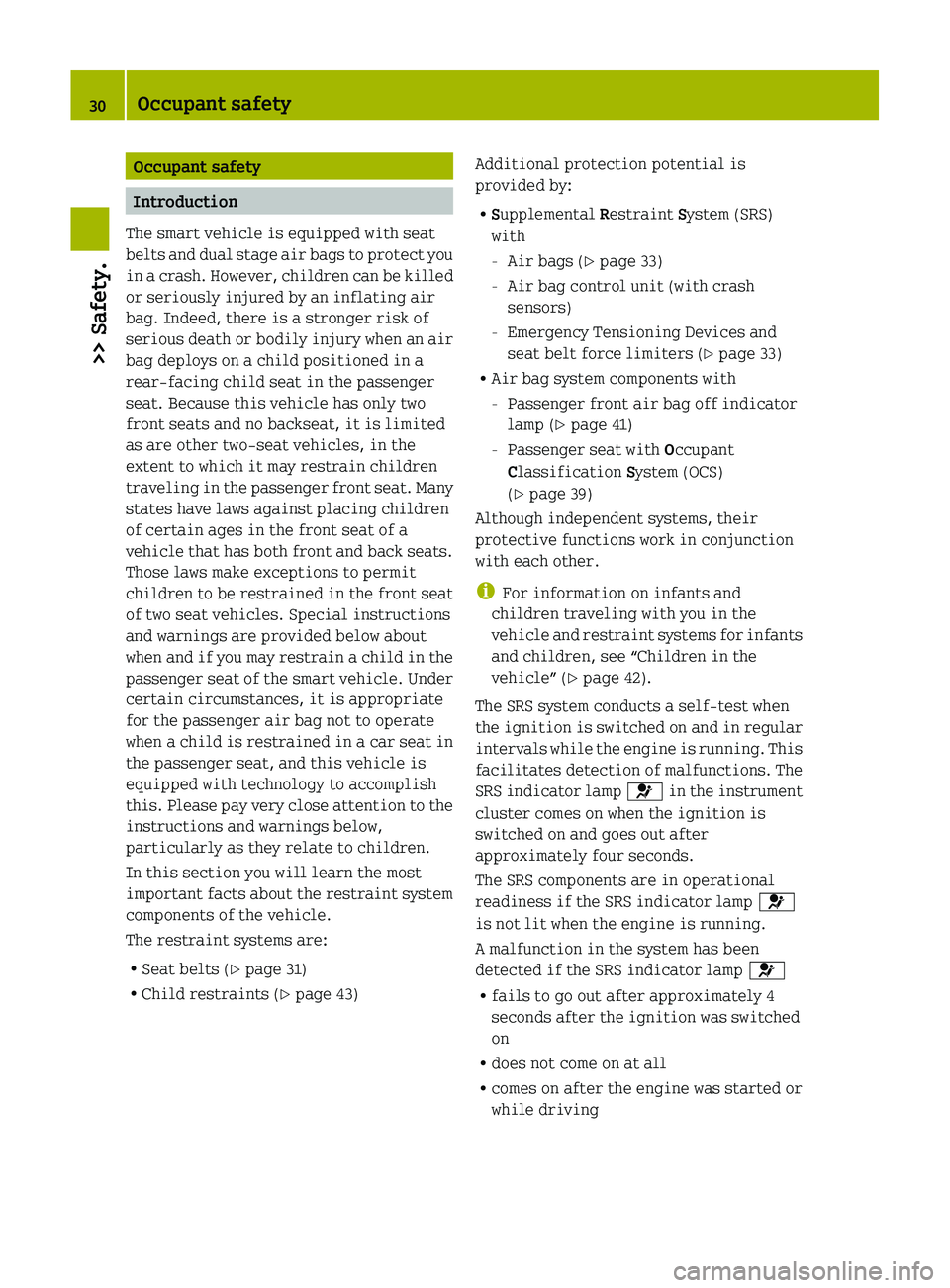
Occupant safety
Introduction
The smart vehicle is equipped with seat
belts and dual stage air bags to protect you
in a crash. However, children can be killed
or seriously injured by an inflating air
bag. Indeed, there is a stronger risk of
serious death or bodily injury when an air
bag deploys on a child positioned in a
rear-facing child seat in the passenger
seat. Because this vehicle has only two
front seats and no backseat, it is limited
as are other two-seat vehicles, in the
extent to which it may restrain children
traveling in the passenger front seat. Many
states have laws against placing children
of certain ages in the front seat of a
vehicle that has both front and back seats.
Those laws make exceptions to permit
children to be restrained in the front seat
of two seat vehicles. Special instructions
and warnings are provided below about
when and if you may restrain a child in the
passenger seat of the smart vehicle. Under
certain circumstances, it is appropriate
for the passenger air bag not to operate
when a child is restrained in a car seat in
the passenger seat, and this vehicle is
equipped with technology to accomplish
this. Please pay very close attention to the
instructions and warnings below,
particularly as they relate to children.
In this section you will learn the most
important facts about the restraint system
components of the vehicle.
The restraint systems are:
R Seat belts ( Y page 31)
R Child restraints ( Y page 43)
Additional protection potential is
provided by:
R Supplemental Restraint System (SRS)
with
- Air bags ( Y page 33)
- Air bag control unit (with crash
sensors)
- Emergency Tensioning Devices and
seat belt force limiters ( Y page 33)
R Air bag system components with
- Passenger front air bag off indicator
lamp ( Y page 41)
- Passenger seat with Occupant
C lassification System (OCS)
( Y page 39)
Although independent systems, their
protective functions work in conjunction
with each other.
i For information on infants and
children traveling with you in the
vehicle and restraint systems for infants
and children, see “Children in the
vehicle” ( Y page 42).
The SRS system conducts a self-test when
the ignition is switched on and in regular
intervals while the engine is running. This
facilitates detection of malfunctions. The
SRS indicator lamp 0081 in the instrument
cluster comes on when the ignition is
switched on and goes out after
approximately four seconds.
The SRS components are in operational
readiness if the SRS indicator lamp 0081
is not lit when the engine is running.
A malfunction in the system has been
detected if the SRS indicator lamp 0081
R fails to go out after approximately 4
seconds after the ignition was switched
on
R does not come on at all
R comes on after the engine was started or
while driving30Occupant safety>> Safety.
BA 451 USA, CA Edition A 2011; 1; 4, en-UShereepeVersion: 3.0.3.62010-05-11T15:12:26+02:00 - Seite 30
Page 33 of 228
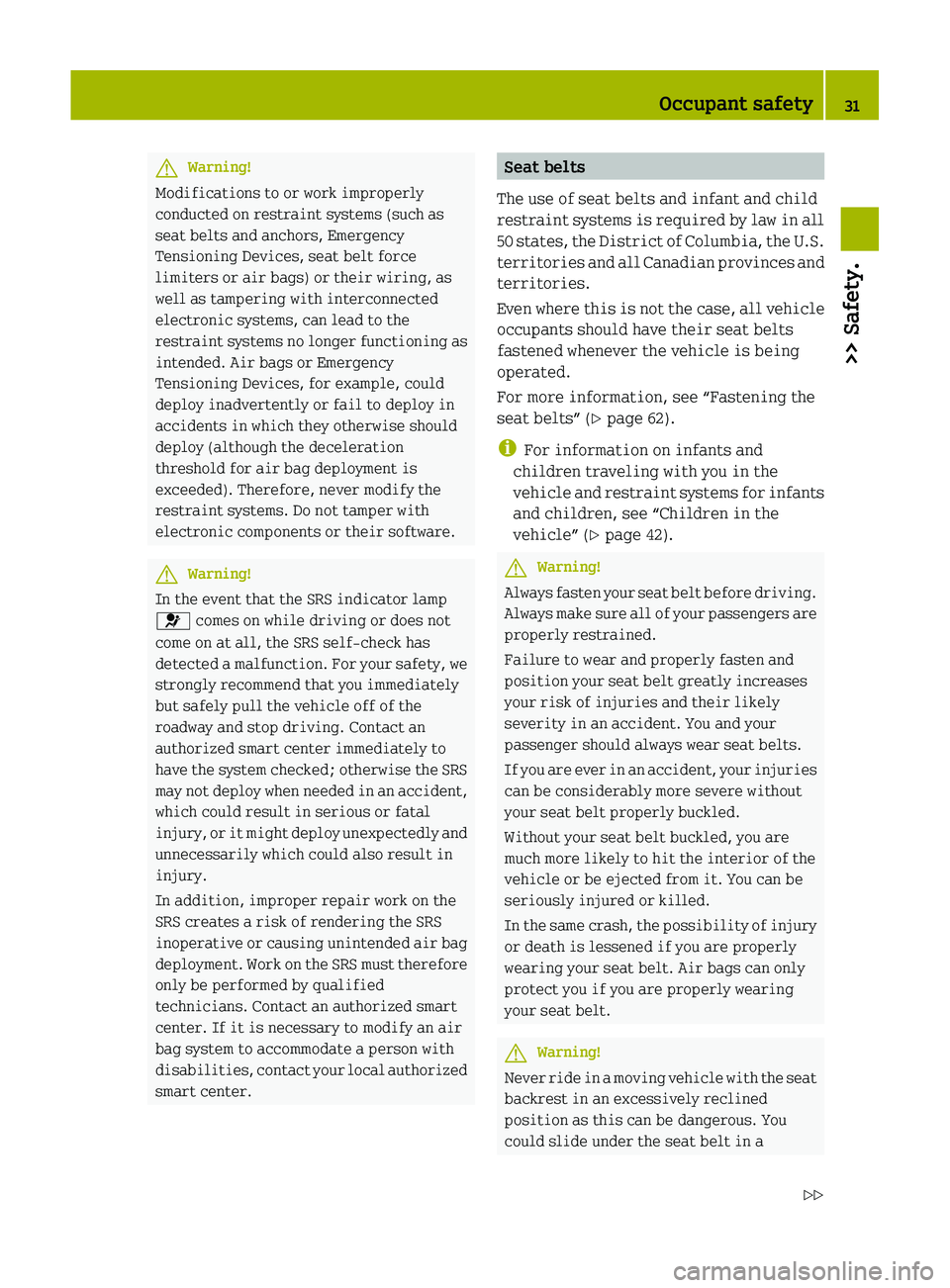
GWarning!
Modifications to or work improperly
conducted on restraint systems (such as
seat belts and anchors, Emergency
Tensioning Devices, seat belt force
limiters or air bags) or their wiring, as
well as tampering with interconnected
electronic systems, can lead to the
restraint systems no longer functioning as
intended. Air bags or Emergency
Tensioning Devices, for example, could
deploy inadvertently or fail to deploy in
accidents in which they otherwise should
deploy (although the deceleration
threshold for air bag deployment is
exceeded). Therefore, never modify the
restraint systems. Do not tamper with
electronic components or their software.
GWarning!
In the event that the SRS indicator lamp
0081 comes on while driving or does not
come on at all, the SRS self-check has
detected a malfunction. For your safety, we
strongly recommend that you immediately
but safely pull the vehicle off of the
roadway and stop driving. Contact an
authorized smart center immediately to
have the system checked; otherwise the SRS
may not deploy when needed in an accident,
which could result in serious or fatal
injury, or it might deploy unexpectedly and
unnecessarily which could also result in
injury.
In addition, improper repair work on the
SRS creates a risk of rendering the SRS
inoperative or causing unintended air bag
deployment. Work on the SRS must therefore
only be performed by qualified
technicians. Contact an authorized smart
center. If it is necessary to modify an air
bag system to accommodate a person with
disabilities, contact your local authorized
smart center.
Seat belts
The use of seat belts and infant and child
restraint systems is required by law in all
50 states, the District of Columbia, the U.S.
territories and all Canadian provinces and
territories.
Even where this is not the case, all vehicle
occupants should have their seat belts
fastened whenever the vehicle is being
operated.
For more information, see “Fastening the
seat belts” ( Y page 62).
i For information on infants and
children traveling with you in the
vehicle and restraint systems for infants
and children, see “Children in the
vehicle” ( Y page 42).GWarning!
Always fasten your seat belt before driving.
Always make sure all of your passengers are
properly restrained.
Failure to wear and properly fasten and
position your seat belt greatly increases
your risk of injuries and their likely
severity in an accident. You and your
passenger should always wear seat belts.
If you are ever in an accident, your injuries
can be considerably more severe without
your seat belt properly buckled.
Without your seat belt buckled, you are
much more likely to hit the interior of the
vehicle or be ejected from it. You can be
seriously injured or killed.
In the same crash, the possibility of injury
or death is lessened if you are properly
wearing your seat belt. Air bags can only
protect you if you are properly wearing
your seat belt.
GWarning!
Never ride in a moving vehicle with the seat
backrest in an excessively reclined
position as this can be dangerous. You
could slide under the seat belt in a
Occupant safety31>> Safety.BA 451 USA, CA Edition A 2011; 1; 4, en-UShereepeVersion: 3.0.3.62010-05-11T15:12:26+02:00 - Seite 31Z
Page 34 of 228
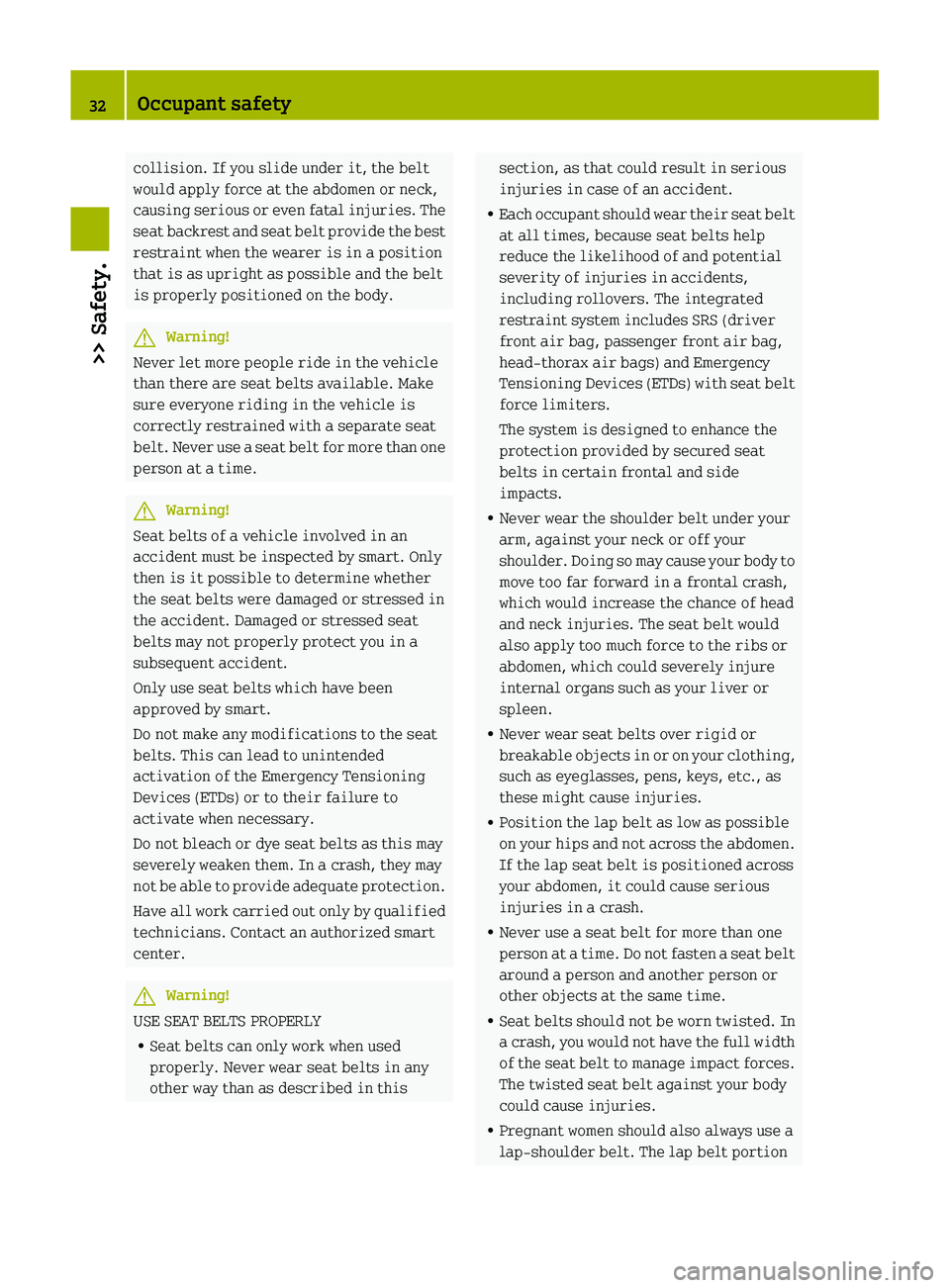
collision. If you slide under it, the belt
would apply force at the abdomen or neck,
causing serious or even fatal injuries. The
seat backrest and seat belt provide the best
restraint when the wearer is in a position
that is as upright as possible and the belt
is properly positioned on the body.GWarning!
Never let more people ride in the vehicle
than there are seat belts available. Make
sure everyone riding in the vehicle is
correctly restrained with a separate seat
belt. Never use a seat belt for more than one
person at a time.
GWarning!
Seat belts of a vehicle involved in an
accident must be inspected by smart. Only
then is it possible to determine whether
the seat belts were damaged or stressed in
the accident. Damaged or stressed seat
belts may not properly protect you in a
subsequent accident.
Only use seat belts which have been
approved by smart.
Do not make any modifications to the seat
belts. This can lead to unintended
activation of the Emergency Tensioning
Devices (ETDs) or to their failure to
activate when necessary.
Do not bleach or dye seat belts as this may
severely weaken them. In a crash, they may
not be able to provide adequate protection.
Have all work carried out only by qualified
technicians. Contact an authorized smart
center.
GWarning!
USE SEAT BELTS PROPERLY
R Seat belts can only work when used
properly. Never wear seat belts in any
other way than as described in this
section, as that could result in serious
injuries in case of an accident.
R Each occupant should wear their seat belt
at all times, because seat belts help
reduce the likelihood of and potential
severity of injuries in accidents,
including rollovers. The integrated
restraint system includes SRS (driver
front air bag, passenger front air bag,
head-thorax air bags) and Emergency
Tensioning Devices (ETDs) with seat belt
force limiters.
The system is designed to enhance the
protection provided by secured seat
belts in certain frontal and side
impacts.
R Never wear the shoulder belt under your
arm, against your neck or off your
shoulder. Doing so may cause your body to
move too far forward in a frontal crash,
which would increase the chance of head
and neck injuries. The seat belt would
also apply too much force to the ribs or
abdomen, which could severely injure
internal organs such as your liver or
spleen.
R Never wear seat belts over rigid or
breakable objects in or on your clothing,
such as eyeglasses, pens, keys, etc., as
these might cause injuries.
R Position the lap belt as low as possible
on your hips and not across the abdomen.
If the lap seat belt is positioned across
your abdomen, it could cause serious
injuries in a crash.
R Never use a seat belt for more than one
person at a time. Do not fasten a seat belt
around a person and another person or
other objects at the same time.
R Seat belts should not be worn twisted. In
a crash, you would not have the full width
of the seat belt to manage impact forces.
The twisted seat belt against your body
could cause injuries.
R Pregnant women should also always use a
lap-shoulder belt. The lap belt portion32Occupant safety>> Safety.
BA 451 USA, CA Edition A 2011; 1; 4, en-UShereepeVersion: 3.0.3.62010-05-11T15:12:26+02:00 - Seite 32
Page 35 of 228
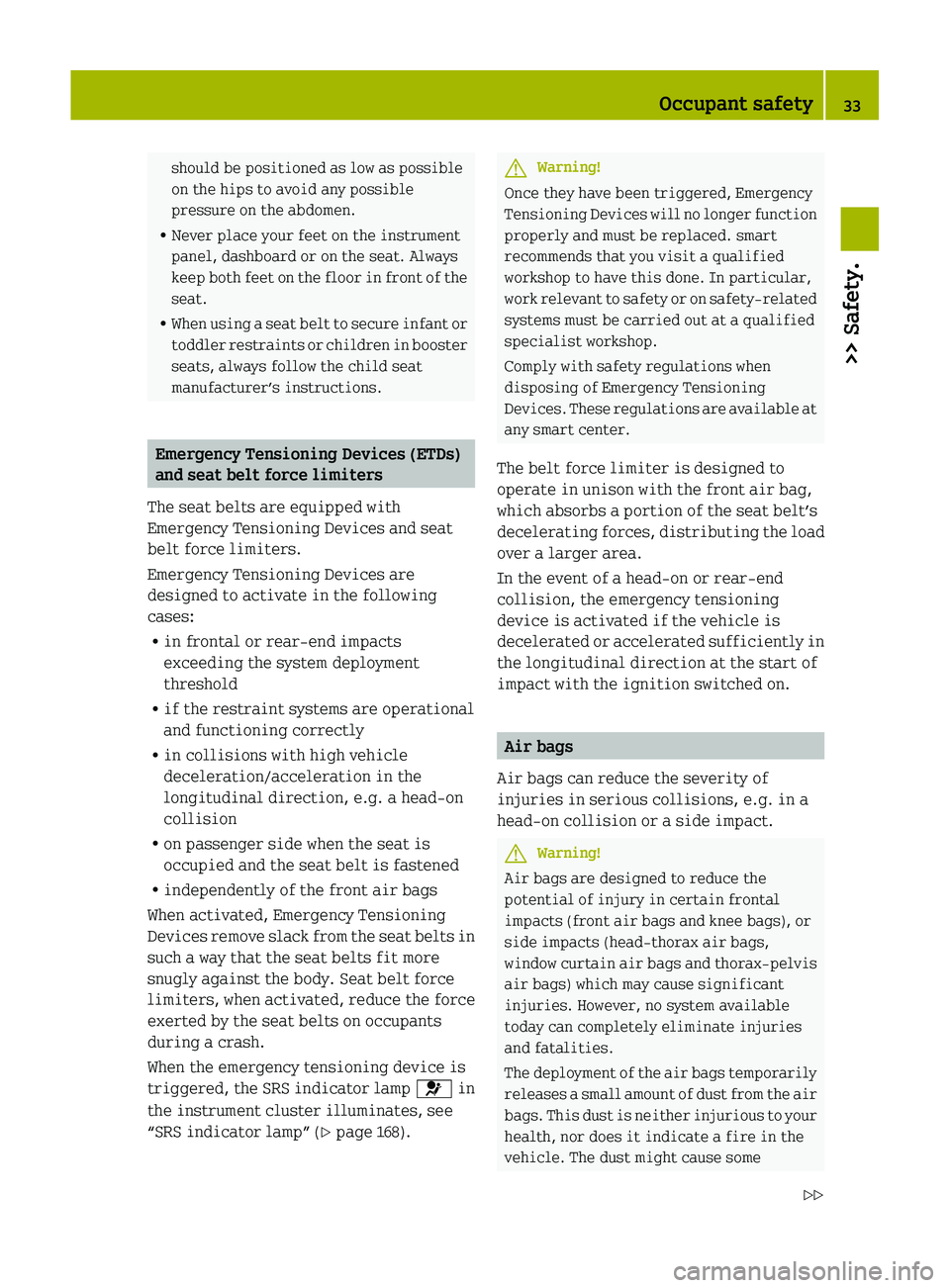
should be positioned as low as possible
on the hips to avoid any possible
pressure on the abdomen.
R Never place your feet on the instrument
panel, dashboard or on the seat. Always
keep both feet on the floor in front of the
seat.
R When using a seat belt to secure infant or
toddler restraints or children in booster
seats, always follow the child seat
manufacturer’s instructions.
Emergency Tensioning Devices (ETDs)
and seat belt force limiters
The seat belts are equipped with
Emergency Tensioning Devices and seat
belt force limiters.
Emergency Tensioning Devices are
designed to activate in the following
cases:
R in frontal or rear-end impacts
exceeding the system deployment
threshold
R if the restraint systems are operational
and functioning correctly
R in collisions with high vehicle
deceleration/acceleration in the
longitudinal direction, e.g. a head-on
collision
R on passenger side when the seat is
occupied and the seat belt is fastened
R independently of the front air bags
When activated, Emergency Tensioning
Devices remove slack from the seat belts in
such a way that the seat belts fit more
snugly against the body. Seat belt force
limiters, when activated, reduce the force
exerted by the seat belts on occupants
during a crash.
When the emergency tensioning device is
triggered, the SRS indicator lamp 0081 in
the instrument cluster illuminates, see
“SRS indicator lamp” ( Y page 168).
GWarning!
Once they have been triggered, Emergency
Tensioning Devices will no longer function
properly and must be replaced. smart
recommends that you visit a qualified
workshop to have this done. In particular,
work relevant to safety or on safety-related
systems must be carried out at a qualified
specialist workshop.
Comply with safety regulations when
disposing of Emergency Tensioning
Devices. These regulations are available at
any smart center.
The belt force limiter is designed to
operate in unison with the front air bag,
which absorbs a portion of the seat belt’s
decelerating forces, distributing the load
over a larger area.
In the event of a head-on or rear-end
collision, the emergency tensioning
device is activated if the vehicle is
decelerated or accelerated sufficiently in
the longitudinal direction at the start of
impact with the ignition switched on.
Air bags
Air bags can reduce the severity of
injuries in serious collisions, e.g. in a
head-on collision or a side impact.
GWarning!
Air bags are designed to reduce the
potential of injury in certain frontal
impacts (front air bags and knee bags), or
side impacts (head-thorax air bags,
window curtain air bags and thorax-pelvis
air bags) which may cause significant
injuries. However, no system available
today can completely eliminate injuries
and fatalities.
The deployment of the air bags temporarily
releases a small amount of dust from the air
bags. This dust is neither injurious to your
health, nor does it indicate a fire in the
vehicle. The dust might cause some
Occupant safety33>> Safety.BA 451 USA, CA Edition A 2011; 1; 4, en-UShereepeVersion: 3.0.3.62010-05-11T15:12:26+02:00 - Seite 33Z
Page 36 of 228
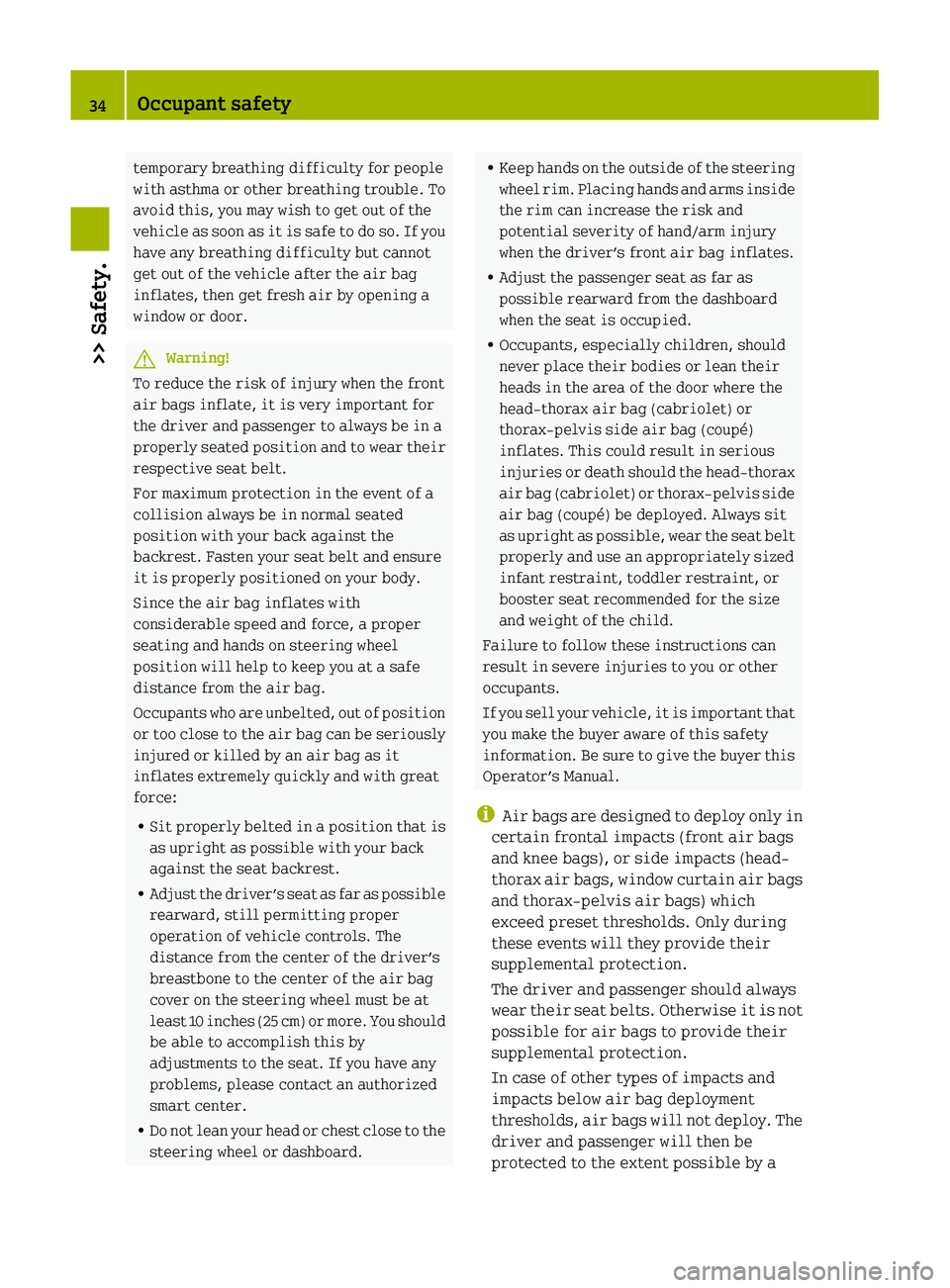
temporary breathing difficulty for people
with asthma or other breathing trouble. To
avoid this, you may wish to get out of the
vehicle as soon as it is safe to do so. If you
have any breathing difficulty but cannot
get out of the vehicle after the air bag
inflates, then get fresh air by opening a
window or door.GWarning!
To reduce the risk of injury when the front
air bags inflate, it is very important for
the driver and passenger to always be in a
properly seated position and to wear their
respective seat belt.
For maximum protection in the event of a
collision always be in normal seated
position with your back against the
backrest. Fasten your seat belt and ensure
it is properly positioned on your body.
Since the air bag inflates with
considerable speed and force, a proper
seating and hands on steering wheel
position will help to keep you at a safe
distance from the air bag.
Occupants who are unbelted, out of position
or too close to the air bag can be seriously
injured or killed by an air bag as it
inflates extremely quickly and with great
force:
R Sit properly belted in a position that is
as upright as possible with your back
against the seat backrest.
R Adjust the driver’s seat as far as possible
rearward, still permitting proper
operation of vehicle controls. The
distance from the center of the driver’s
breastbone to the center of the air bag
cover on the steering wheel must be at
least 10 inches (25 cm) or more. You should
be able to accomplish this by
adjustments to the seat. If you have any
problems, please contact an authorized
smart center.
R Do not lean your head or chest close to the
steering wheel or dashboard.
R Keep hands on the outside of the steering
wheel rim. Placing hands and arms inside
the rim can increase the risk and
potential severity of hand/arm injury
when the driver’s front air bag inflates.
R Adjust the passenger seat as far as
possible rearward from the dashboard
when the seat is occupied.
R Occupants, especially children, should
never place their bodies or lean their
heads in the area of the door where the
head-thorax air bag (cabriolet) or
thorax-pelvis side air bag (coupé)
inflates. This could result in serious
injuries or death should the head-thorax
air bag (cabriolet) or thorax-pelvis side
air bag (coupé) be deployed. Always sit
as upright as possible, wear the seat belt
properly and use an appropriately sized
infant restraint, toddler restraint, or
booster seat recommended for the size
and weight of the child.
Failure to follow these instructions can
result in severe injuries to you or other
occupants.
If you sell your vehicle, it is important that
you make the buyer aware of this safety
information. Be sure to give the buyer this
Operator’s Manual.
i Air bags are designed to deploy only in
certain frontal impacts (front air bags
and knee bags), or side impacts (head-
thorax air bags, window curtain air bags
and thorax-pelvis air bags) which
exceed preset thresholds. Only during
these events will they provide their
supplemental protection.
The driver and passenger should always
wear their seat belts. Otherwise it is not
possible for air bags to provide their
supplemental protection.
In case of other types of impacts and
impacts below air bag deployment
thresholds, air bags will not deploy. The
driver and passenger will then be
protected to the extent possible by a34Occupant safety>> Safety.
BA 451 USA, CA Edition A 2011; 1; 4, en-UShereepeVersion: 3.0.3.62010-05-11T15:12:26+02:00 - Seite 34
Page 37 of 228
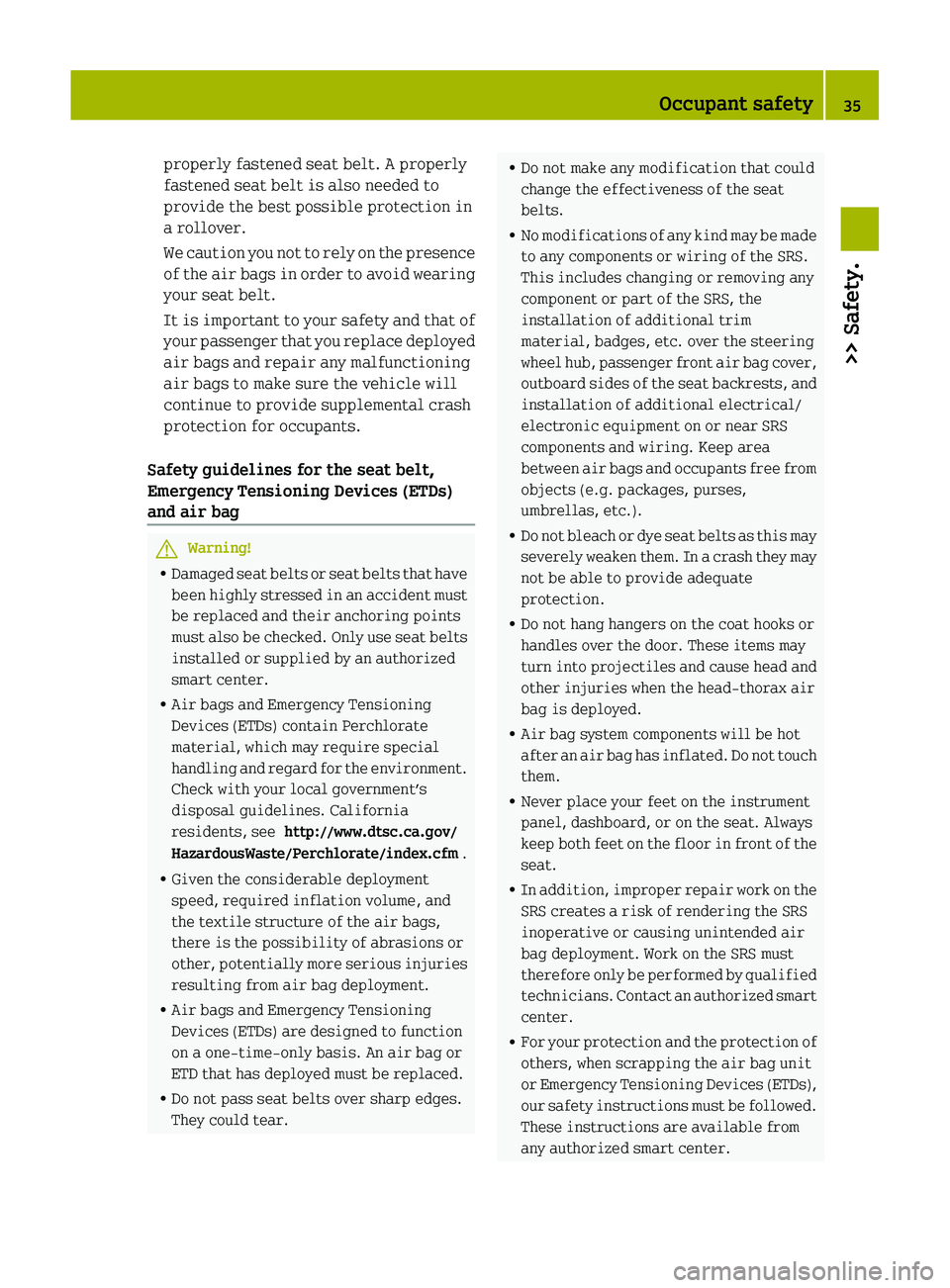
properly fastened seat belt. A properly
fastened seat belt is also needed to
provide the best possible protection in
a rollover.
We caution you not to rely on the presence
of the air bags in order to avoid wearing
your seat belt.
It is important to your safety and that of
your passenger that you replace deployed
air bags and repair any malfunctioning
air bags to make sure the vehicle will
continue to provide supplemental crash
protection for occupants.
Safety guidelines for the seat belt,
Emergency Tensioning Devices (ETDs)
and air bag GWarning!
R Damaged seat belts or seat belts that have
been highly stressed in an accident must
be replaced and their anchoring points
must also be checked. Only use seat belts
installed or supplied by an authorized
smart center.
R Air bags and Emergency Tensioning
Devices (ETDs) contain Perchlorate
material, which may require special
handling and regard for the environment.
Check with your local government’s
disposal guidelines. California
residents, see http://www.dtsc.ca.gov/
HazardousWaste/Perchlorate/index.cfm .
R Given the considerable deployment
speed, required inflation volume, and
the textile structure of the air bags,
there is the possibility of abrasions or
other, potentially more serious injuries
resulting from air bag deployment.
R Air bags and Emergency Tensioning
Devices (ETDs) are designed to function
on a one-time-only basis. An air bag or
ETD that has deployed must be replaced.
R Do not pass seat belts over sharp edges.
They could tear.
R Do not make any modification that could
change the effectiveness of the seat
belts.
R No modifications of any kind may be made
to any components or wiring of the SRS.
This includes changing or removing any
component or part of the SRS, the
installation of additional trim
material, badges, etc. over the steering
wheel hub, passenger front air bag cover,
outboard sides of the seat backrests, and
installation of additional electrical/
electronic equipment on or near SRS
components and wiring. Keep area
between air bags and occupants free from
objects (e.g. packages, purses,
umbrellas, etc.).
R Do not bleach or dye seat belts as this may
severely weaken them. In a crash they may
not be able to provide adequate
protection.
R Do not hang hangers on the coat hooks or
handles over the door. These items may
turn into projectiles and cause head and
other injuries when the head-thorax air
bag is deployed.
R Air bag system components will be hot
after an air bag has inflated. Do not touch
them.
R Never place your feet on the instrument
panel, dashboard, or on the seat. Always
keep both feet on the floor in front of the
seat.
R In addition, improper repair work on the
SRS creates a risk of rendering the SRS
inoperative or causing unintended air
bag deployment. Work on the SRS must
therefore only be performed by qualified
technicians. Contact an authorized smart
center.
R For your protection and the protection of
others, when scrapping the air bag unit
or Emergency Tensioning Devices (ETDs),
our safety instructions must be followed.
These instructions are available from
any authorized smart center.Occupant safety35>> Safety.BA 451 USA, CA Edition A 2011; 1; 4, en-UShereepeVersion: 3.0.3.62010-05-11T15:12:26+02:00 - Seite 35Z
Page 38 of 228
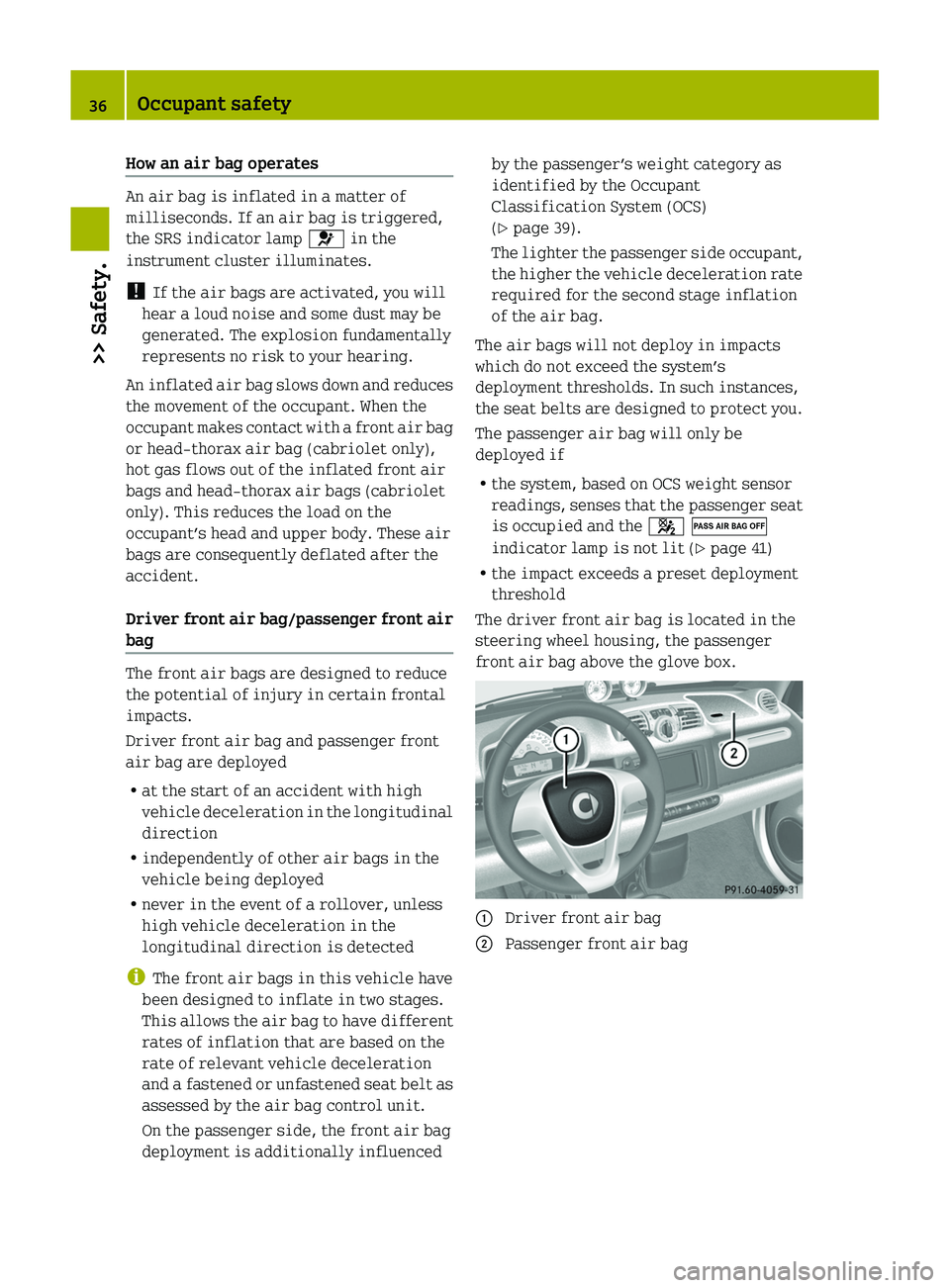
How an air bag operates
An air bag is inflated in a matter of
milliseconds. If an air bag is triggered,
the SRS indicator lamp \000
Page 39 of 228
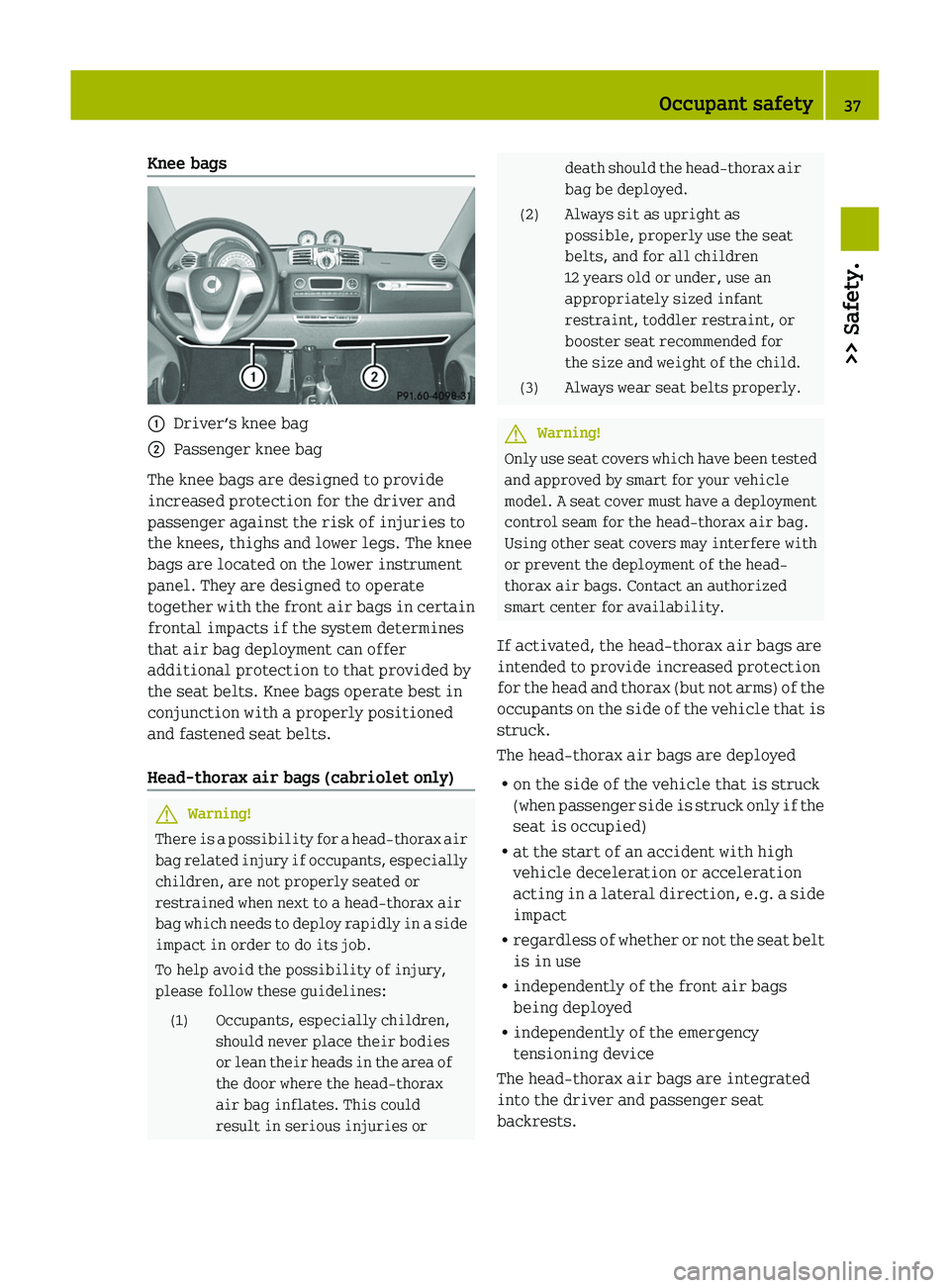
Knee bags0046Driver’s knee bag0047Passenger knee bag
The knee bags are designed to provide
increased protection for the driver and
passenger against the risk of injuries to
the knees, thighs and lower legs. The knee
bags are located on the lower instrument
panel. They are designed to operate
together with the front air bags in certain
frontal impacts if the system determines
that air bag deployment can offer
additional protection to that provided by
the seat belts. Knee bags operate best in
conjunction with a properly positioned
and fastened seat belts.
Head-thorax air bags (cabriolet only)
GWarning!
There is a possibility for a head-thorax air
bag related injury if occupants, especially
children, are not properly seated or
restrained when next to a head-thorax air
bag which needs to deploy rapidly in a side
impact in order to do its job.
To help avoid the possibility of injury,
please follow these guidelines:
(1)Occupants, especially children,
should never place their bodies
or lean their heads in the area of
the door where the head-thorax
air bag inflates. This could
result in serious injuries ordeath should the head-thorax air
bag be deployed.(2)Always sit as upright as
possible, properly use the seat
belts, and for all children
12 years old or under, use an
appropriately sized infant
restraint, toddler restraint, or
booster seat recommended for
the size and weight of the child.(3)Always wear seat belts properly.GWarning!
Only use seat covers which have been tested
and approved by smart for your vehicle
model. A seat cover must have a deployment
control seam for the head-thorax air bag.
Using other seat covers may interfere with
or prevent the deployment of the head-
thorax air bags. Contact an authorized
smart center for availability.
If activated, the head-thorax air bags are
intended to provide increased protection
for the head and thorax (but not arms) of the
occupants on the side of the vehicle that is
struck.
The head-thorax air bags are deployed
R on the side of the vehicle that is struck
(when passenger side is struck only if the
seat is occupied)
R at the start of an accident with high
vehicle deceleration or acceleration
acting in a lateral direction, e.g. a side
impact
R regardless of whether or not the seat belt
is in use
R independently of the front air bags
being deployed
R independently of the emergency
tensioning device
The head-thorax air bags are integrated
into the driver and passenger seat
backrests.
Occupant safety37>> Safety.BA 451 USA, CA Edition A 2011; 1; 4, en-UShereepeVersion: 3.0.3.62010-05-11T15:12:26+02:00 - Seite 37Z
Page 40 of 228
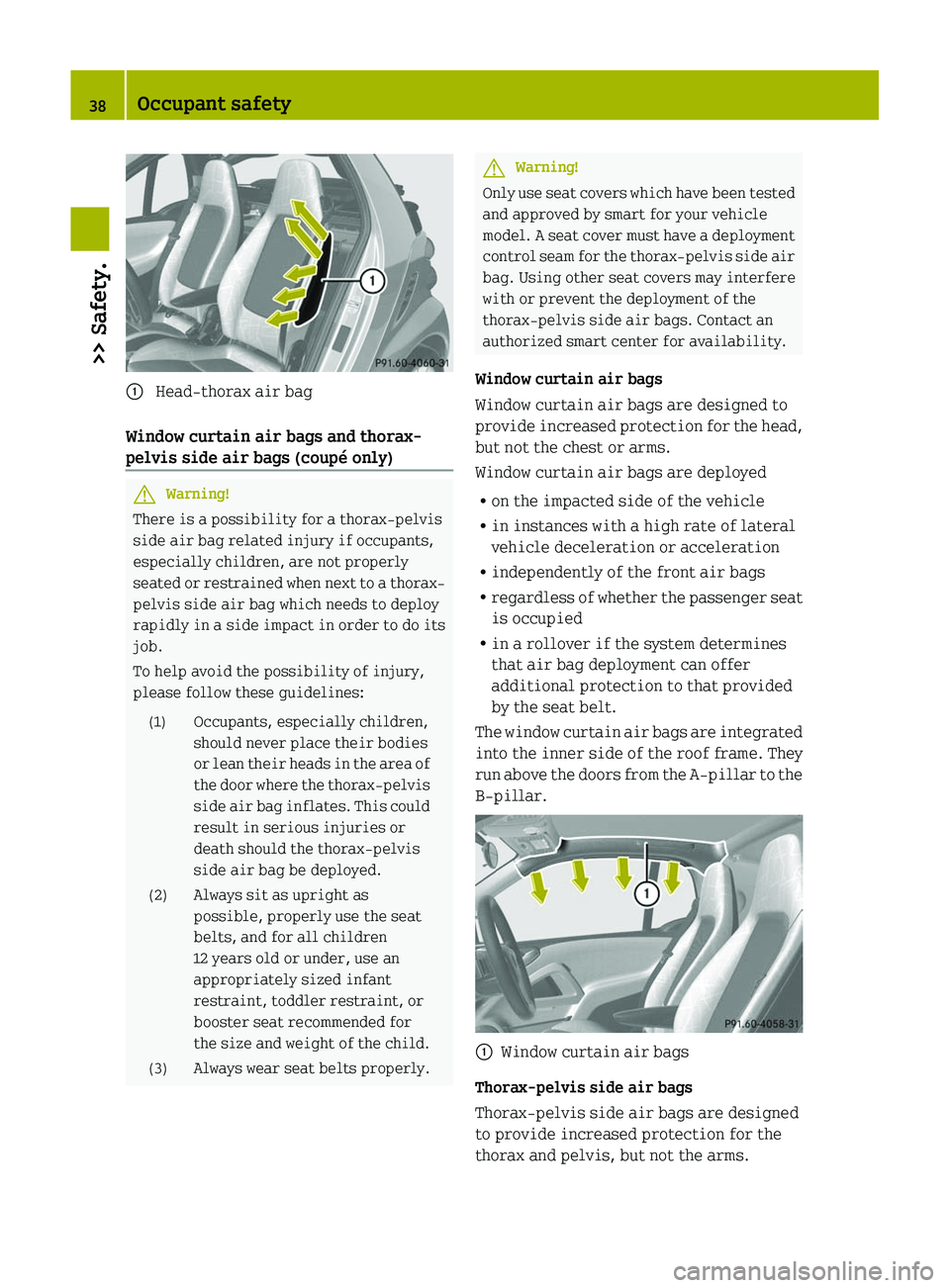
\000F Head-thorax air bag
Window curtain air bags and thorax-
pelvis side air bags (coupé only)
GWarning!
There is a possibility for a thorax-pelvis
side air bag related injury if occupants,
especially children, are not properly
seated or restrained when next to a thorax-
pelvis side air bag which needs to deploy
rapidly in a side impact in order to do its
job.
To help avoid the possibility of injury,
please follow these guidelines:
(1)Occupants, especially children,
should never place their bodies
or lean their heads in the area of
the door where the thorax-pelvis
side air bag inflates. This could
result in serious injuries or
death should the thorax-pelvis
side air bag be deployed.
(2)Always sit as upright as
possible, properly use the seat
belts, and for all children
12 years old or under, use an
appropriately sized infant
restraint, toddler restraint, or
booster seat recommended for
the size and weight of the child.
(3)Always wear seat belts properly.GWarning!
Only use seat covers which have been tested
and approved by smart for your vehicle
model. A seat cover must have a deployment
control seam for the thorax-pelvis side air
bag. Using other seat covers may interfere
with or prevent the deployment of the
thorax-pelvis side air bags. Contact an
authorized smart center for availability.
Window curtain air bags
Window curtain air bags are designed to
provide increased protection for the head,
but not the chest or arms.
Window curtain air bags are deployed
Ron the impacted side of the vehicle
Rin instances with a high rate of lateral
vehicle deceleration or acceleration
Rindependently of the front air bags
Rregardless of whether the passenger seat
is occupied
Rin a rollover if the system determines
that air bag deployment can offer
additional protection to that provided
by the seat belt.
The window curtain air bags are integrated
into the inner side of the roof frame. They
run above the doors from the A-pillar to the
B-pillar.
\000FWindow curtain air bags
Thorax-pelvis side air bags
Thorax-pelvis side air bags are designed
to provide increased protection for the
thorax and pelvis, but not the arms.
38Occupant safety>> Safety.
BA 451 USA, CA Edition A 2011; 1; 4, en-UShereepeVersion: 3.0.3.62010-05-11T15:12:26+02:00 - Seite 38